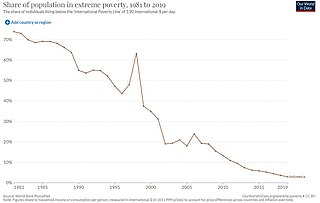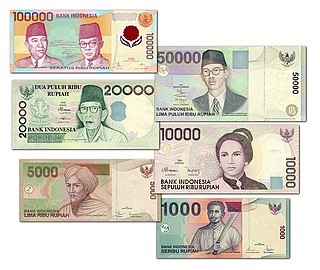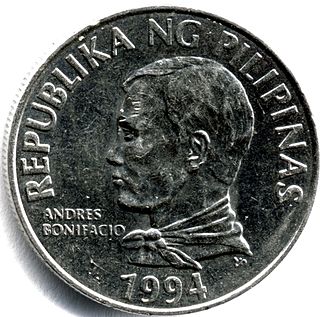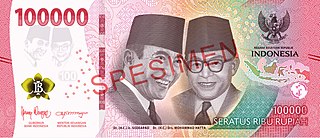
The Malaysian ringgit is the currency of Malaysia. It is divided into 100 sen. The ringgit is issued by the Central Bank of Malaysia.

The rupiah is the official currency of Indonesia, issued and controlled by Bank Indonesia. Its name is derived from the Sanskrit word for silver, rupyakam (रूप्यकम्). Sometimes, Indonesians also informally use the word perak in referring to rupiah in coins. The rupiah is divided into 100 cents, although high inflation has rendered all coins and banknotes denominated in cents obsolete.

Nias is an island located off the western coast of Sumatra, Indonesia. Nias is also the name of the archipelago of which the island is the centre, but also includes the Batu Islands to the south-east and the small Hinako Islands to the west. Nias Island covers an area of 5,625.0 km2 (2,171.8 sq mi). It is mostly a lowland area rising to around 800 m (2,600 ft) above sea level. There were 756,338 inhabitants on the island at the 2010 Census; at the 2015 Intermediate Census this had risen to 798,506 and the 2020 Census resulted in a total of 880,550. The official estimate as at mid 2022 was 902,632.

Poverty in Indonesia is a widespread issue though in recent years the official numbers show a declining trend. Due to the dense rural nature of parts of the Java, Bali, Lombok, and parts of Sumatra, poverty can be classified into rural and urban poverty. Urban poverty is prevalent in not only in Jabodetabek, but also in Medan and Surabaya.

The Swiss franc has been the currency of Liechtenstein since 1920. The Swiss franc is legal tender since Liechtenstein is in a customs and monetary union with Switzerland. The 1980 treaty between Switzerland and Liechtenstein allows Liechtenstein to mint limited amounts of Swiss francs with a Liechtenstein inscription, but only in the form of commemorative coins, and they are not allowed to issue banknotes.

The first coins of the Indonesian rupiah were issued in 1951 and 1952, a year or so later than the first Indonesian rupiah banknotes printed, following the peace treaty with the Netherlands in November 1949. Although revolutionary currency had been issued by the provisional Indonesian government between 1945 and 1949, it had all been formed of paper, for metal were too scarce for the internationally isolated government to use as currency.

The first banknotes used in the archipelago that would become Indonesia were those issued by the United East India Company, credit letters of the rijksdaalder dating between 1783 and 1811. Netherlands Indies gulden government credit paper followed in 1815, and from 1827 to 1842 and again from 1866 to 1948 gulden notes of De Javasche Bank. Lower denominations were issued by the government in 1919–1920 and in 1939–1940 due to wartime metal shortages, but otherwise day-to-day transactions were conducted using coinage.
During World War II, the Belgian government needed to mint coins using metal that would not be needed for the war effort. Therefore, silver coinage was discontinued and coins were instead minted using pure zinc.

The Indian 10-rupee coin is a denomination of the Indian rupee. The ₹10 coin is the second highest-denomination coin minted in India since its introduction in 2005. The present ₹10 coin in circulation is from the 2019 design. However, the previous ₹10 coins minted before 2019 are also legal tender in India. All ₹10 coins containing with and without the rupee currency sign are legal tender, as stated by the Reserve Bank of India. Along with the standard designs, there are 4 different designs for this denomination and this is used alongside the 10 rupee banknote.
The 5,000 yen coin is a denomination of the Japanese yen used only for commemoratives struck by the Japan Mint. These are made only for collectors who purchase them directly from the mint at a premium. 5000 yen commemorative coins have historically been struck in a silver alloy since 1990. This practice changed in 2021 when gold was used for the first time for a coin celebrating 150 years of Japan's modern currency system. Measurements for the coins in terms of width and weight have remained the same except for the gold issue when these were lowered. Earlier coins were also once struck in the millions before the alloy change took place.

The Philippine two-peso coin (₱2) was a denomination of Philippine currency. It was minted by the Bangko Sentral ng Pilipinas from 1983 to 1994 and was demonetized in 1998.

PT Bank Pembangunan Daerah Kalimantan Timur dan Kalimantan Utara, doing business as Bankaltimtara, is an Indonesian regional development bank serving East Kalimantan and North Kalimantan. It was previously known as Bank Kaltim or East Kalimantan Bank until 2017 when the company was renamed after new North Kalimantan province was created. It is also one of the biggest compared to other province's regional development banks in Indonesia.
National Dayak Customary Council is an official customary council of the Dayak people in Indonesia that acts as the highest authority over other cultural or traditional councils of the Dayak people. It has branches from the provincial level to the village level in the entire Kalimantan and is funded by the Indonesian government. It was established on 5 September 2006 after the 2nd National Indonesian Dayak Conference in Pontianak regarding matters of funding the organization and its structure, and has been incorporated into laws by various local governments in Kalimantan. The president of the council is elected by representatives of regional branches for a five year term. The current president of the council from 2021 to 2026 is Marthin Billa, who was previously regent of Malinau Regency and chief of the North Kalimantan provincial Dayak Council.

The Indonesian one thousand rupiah coin (Rp1,000) is a coin of the Indonesian rupiah. It circulates alongside the 1,000-rupiah banknote. First introduced on 8 March 1993 as bimetallic coins, they are now minted as unimetallic coins, with the first of its kind appearing in 2010 and its latest revision being in 2016. As of 2024, the last two series in this denomination are legal tender.

The Indonesian two hundred rupiah coin (Rp200) is a coin of the Indonesian rupiah. It was first introduced in 2003 and was revised in its current form on December 19, 2016.

The Indonesian two thousand rupiah banknote (Rp2,000) is a denomination of the Indonesian rupiah. First introduced on July 9, 2009, it was made legal tender the following day and has since been modified two times, first in 2016 and then in 2022. All notes of this denomination are printed in cotton paper since its inception.

The fifty rupiah coin (Rp50) is a denomination of the Indonesian rupiah. It was first introduced in 1971 and last minted in 2003. As of 2020, only aluminum Rp50 coins dating from 1999 through 2003 remain legal tender, although it is rarely seen in circulation due to its extremely low value.

The Indonesian twenty five rupiah coin (Rp25) is a now-defunct denomination of the Indonesian rupiah. It was introduced in 1971 and was last revised in 1991. Coins of this denomination were minted until 1996 and have been invalid for transactions since August 31, 2010 when the 1991-issue Rp25 coin ceased to be legal tender.

The Indonesian five hundred rupiah coin (Rp500) is a denomination of the Indonesian rupiah. It was introduced in 1991 and has since been revised three times in 1997, 2003, and 2016. It currently has the second-highest value of all circulating rupiah coins after the Rp1,000 coin. As of December 2023, only alumunium 500 rupiah coins, dated 2003 and 2016, are legal tender.

The Indonesian one hundred thousand rupiah banknote (Rp100,000) is a denomination of the Indonesian rupiah. Being the highest and second-newest denomination of the rupiah, it was first introduced on November 1, 1999, as a polymer banknote before switching to cotton paper in 2004; all notes have been printed using the latter ever since.






















